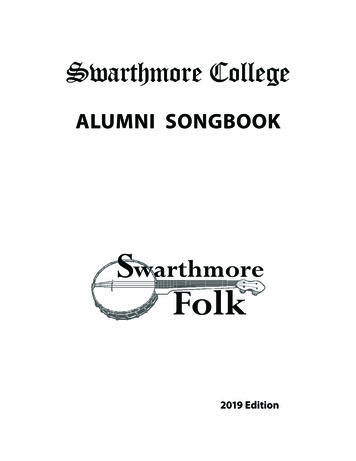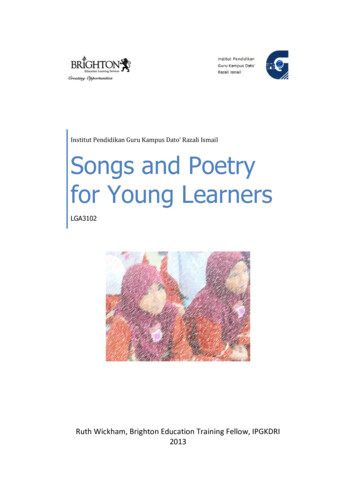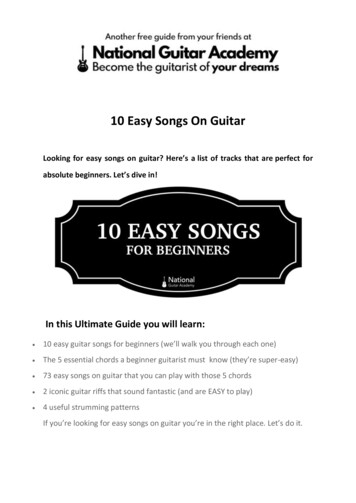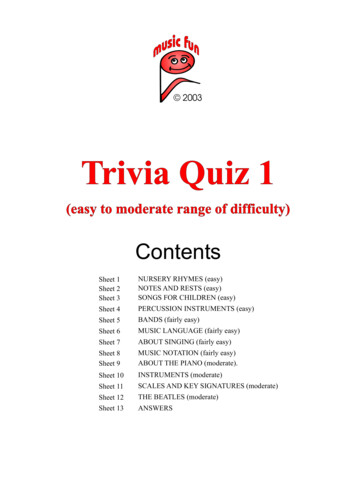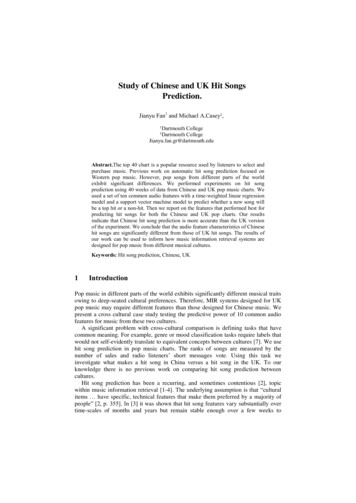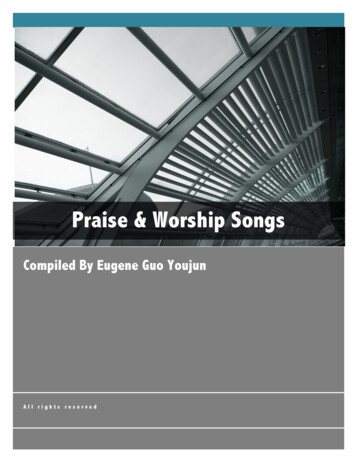
Transcription
The Song of SongsTitle/SuperscriptionThe Desire for Love1:1 Solomon’s Most Excellent Love The Beloved to Her Lover: 1:2 Oh, how I wish you would kiss meSong. tn The preposition ל in למֹה ֹ ’( אֲ ׁ ֶשר ִל ׁ ְש asher lishlomoh) hasbeen taken as: (1) authorship: “which is written by Solomon.”The lamed of authorship (also known as lamed auctoris) iswell attested in Hebrew (see GKC 421 §130.b), particularlyin the Psalms (e.g., Pss 18:1; 30:1; 34:1; 51:1; 52:1; 54:1;56:1; 57:1; 59:1; 60:1; 63:1; 72:1); (2) dedication: “which isdedicated for Solomon.” The lamed of dedication is attested in Ugaritic psalms dedicated to Baal or about Baal (CTA6.1.1 UT 49.1); or (3) topic: “which is about/concerningSolomon.” The lamed of topic is attested in Hebrew (e.g., 1Chr 24:20) and in Ugaritic, e.g., lb l “About Baal” (CTA 6.1.1 UT 49.1). The ל is most likely denoting authorship. The ל followed by a name in the superscription of a poetic composition in the OT, usually (if not always) denotes authorship. Justas the superscription ( ְלדָ וִד lÿdavid) claims Davidic authorshipwithin the Psalter, the heading claims Solomonic authorship.Whether or not this attribution is historically reliable or simplya matter of Jewish tradition is debated in scholarship, just asthe Davidic superscriptions in the Psalter are debated (seestudy note on the word “Song” in the superscription). tn Heb “the song of songs.” The genitive construct ׁ ִשיר ירים ִ ( הַ ׁ ִש shir hashirim) is translated literally as “the song ofsongs” in the early versions: Greek LXX (ᾀσμα ᾀσμάτων,asma asmatwn), Latin Vulgate (canticum canticorum) andSyriac Peshitta (tesŒbÿhat tesŒbÿha„ta„á). The phrase ירים ִ ׁ ִשיר הַ ׁ ִש may be understood in two ways: (1) The noun ירים ִ הַ ׁ ִש is a plural of number (“songs”) and functions as a genitive of composition: “the song composed of several songs,” that is, thebook is a unified collection (hence the singular “ ׁ ִשיר song”)composed of individual love songs (see note on the expression “Her Lover” in v. 1). (2) The expression may be a superlative genitive construction denoting par excellence (see IBHS154 §9.5.3j; GKC 431 §133.i; R. J. Williams, Hebrew Syntax,11, §44; 17-18, §80). For example, ( קֹדֶ ׁש קָ דָ ׁ ִשים qodesh qadashim, “the holy of holies”) means the most holy place (Exod29:37); ’( אֱ לֹהֵ י הָ אֱ ל ִֹהים וַאֲ ֹדנֵי הָ אֲ דֹנִ ים elohe ha’elohim va’adoneha’adonim, “the God of Gods and Lord of Lords”) means theHighest God and the Supreme Lord (Deut 10:17); and עֶ בֶ ד ע ֲָב־ ’( ִדים eved ’avadim,“a slave of slaves”) means an abject slave(Gen 9:25). The title “the Song of Songs” is an expression ofgreat esteem for the composition. It has been translated variously: “The Song of Songs, which is Solomon’s” (KJV, NKJV,RSV, NRSV, NASB), “Solomon’s Song of Songs” (NIV), “Themost beautiful of songs, by Solomon” (TEV), “dedicated to,”or “about Solomon” (TEV margin), “Solomon’s most beautifulsong” (CEV), “This is Solomon’s song of songs, more wonderful than any other” (NLT). tn Heb “song.” The noun ( ׁ ִשיר shir) may refer to a musical song that was sung (Exod 15:1; Num 21:17; Ps 33:3; Isa42:10) or a poetic composition that was simply read (Deut31:19, 21, 22; 30; 32:44) (BDB 1010 s.v. ) ׁשיר . Several factors suggest that the Song of Songs was poetry to be read andenjoyed rather than sung: (a) its sheer length, (b) absence ofmusical notations or instrumental instructions, (c) testimonyof Jewish tradition and interpretation, (d) lack of evidence ofits musical performance in the history of Israel, and (e) comparison with ancient Egyptian love poetry. The term ׁ ִשיר hereprobably refers to love poetry (e.g., Isa 5:1) (BDB 1010 s.v. 1;W. L. Holladay, Concise Hebrew and Aramaic Lexicon, 368).The Song appears to be a collection of individual love songsrather than a single multistanza poem. For comparison of theSong of Songs with ancient Egyptian loves songs, see M. V.Fox, The Song of Songs and the Ancient Egyptian Love Songs,and J. B. White, Language of Love in the Song of Songs andAncient Egyptian Poetry (SBLDS).sn The superscription “Solomon’s Most Excellent LoveSong” appears to be a late addition, just as many superscriptions in the Psalter appear to have been added to the psalmssometime after their original composition. R. E. Murphy (Songof Songs [Hermeneia], 119) notes that the use of the independent relative pronoun ’( אֲ ׁ ֶשר asher) in 1:1 sharply distinguishes the superscription from the body of the Song as awhole where the short form - ( ׁ ֶש she-) occurs thirty-two times(e.g., 1:6, 12; 6:5). The short form - ׁ ֶש also occurs frequentlyin Ecclesiastes which is traditionally attributed to Solomon.Therefore, it would appear that the superscription is a lateraddition to the Song. This, of course, raises the questionwhether or not the attribution of Solomonic authorship of theSong is historically reliable or simply a matter of later Jewishtradition. tn The introductory headings that identify the speakers ofthe poems throughout the Song do not appear in the Hebrewtext. They are supplied in the translation for the sake of clarity. These notations should not be misinterpreted as suggesting that the Song be interpreted as a drama. Throughout theSong, the notation “The Lover” refers to the young man, while“the Beloved” refers to the young woman. Since the Song ofSongs appears to be a collection of individual love songs, theindividual love poems within the collection might not haveoriginally referred to the same young man and young womanin each case. Just as the Book of Proverbs contains proverbscomposed by Solomon (10:1-22:16; 25:1-29:27) as well asproverbs composed by other wise men (22:17-24:34; 30:131:9), so the Song of Songs may contain love poems composed by Solomon or written about Solomon as well as lovepoems composed by or written about other young couples inlove. Nevertheless, the final canonical form of this collectionpresents a unified picture of idyllic love between one man andone woman in each case. The young man in several of theindividual love poems is explicitly identified as Solomon (3:7;8:11-12), King Solomon (3:9, 11) or the king (1:4; 7:6). Somestatements in the Song are consistent with a royal figure suchas Solomon: references to Tirzah and Jerusalem (6:4) and tomultiple queens and concubines (6:8). It is not so clear, however, whether Solomon is the young man in every individualpoem. Nor is it clear that the same young woman is in viewin each love poem. In several poems the young woman is acountry maiden working in a vineyard (1:5-6; 8:11-12); however, the young woman in another poem is addressed as “Oprince’s daughter” (7:2). The historian notes, “Solomon lovedmany women, especially the daughter of Pharaoh” (1 Kgs11:1). So it would be surprising if the Song devoted itself toonly one of Solomon’s many liaisons. The Song may simplybe a collection of love poems written at various moments inSolomon’s illustrious career as a lover of many women. It mayalso include love poems written about other young lovers thatwere collected into the final form of the book that presents aportrait of idyllic love of young lovers. tn Heb “May he kiss me .” The shift from 3rd personmasculine singular forms (“he” and “his”) in 1:2a to 2ndperson masculine singular forms (“your”) in 1:2b-4 has ledsome to suggest that the Beloved addresses the Friends in1:2a and then her Lover in 1:2b-4. A better solution is that theshift from the 3rd person masculine singular to 2nd personmasculine singular forms is an example of heterosis of person: a poetic device in which the grammatical person shiftsfrom line to line (M. H. Pope, Song of Songs [AB], 297). The1225
The Song of Songs 1:31226passionately!For your lovemaking is more delightful than wine. 1:3 The fragrance of your colognes isdelightful; third person is put for the second person (e.g, Gen 49:4; Deut32:15; Ps 23:2-5; Isa 1:29; 42:20; 54:1; Jer 22:24; Amos 4:1;Micah 7:19; Lam 3:1; Song 4:2; 6:6) (E. W. Bullinger, Figuresof Speech, 524-25). Similar shifts occur in ancient Near Eastern love literature (cf. S. N. Kramer, The Sacred Marriage Rite,92, 99). Most translations render 1:2 literally and preservethe shifts from 3rd person masculine singular to 2nd personmasculine singular forms (KJV, AV, NASB, NIV); others render1:2 with 2nd person masculine singular forms throughout(RSV, NJPS). tn Heb “May he kiss me with the kisses of his mouth!”The phrase יִשקֵ נִ י ִמ ְּנ ׁ ִשיקוֹת ָ ּ ׁ (yishshaqeni minnÿshiqot, “kiss mewith kisses”) is a cognate accusative construction used foremphasis. tc The MT vocalizes consonantal דדיך as ָ ( ּדֹדֶ יך dodekha,“your loves”; mpl noun from ּדוֹד , dod, “love” 2nd personmasculine singular suffix). The LXX and Vulgate reflect the vocalization ָ ( ּ ַד ּ ֶדיך daddekha, “your breasts”; mpl noun from ּ ַדד ,dad, “breast” 2nd person masculine singular suffix). Thisalternate tradition was well known; it was followed by Hippolytus of Rome (d. 235) in his exposition of Canticles 1:2 andby Rabbi Yohanan of Tiberias (3rd century a.d.) as recordedin the Jewish midrashim on Canticles Rabbah 1:2.2. However, the MT vocalization is preferred. In terms of external evidence, the MT vocalization tradition is generally more reliable.In terms of internal evidence, the LXX form ָ ( ּ ַד ּ ֶדיך daddekha,“your [male!] breasts”) is a bit shocking, to say the least. Onthe other, the plural form ( ּדו ִֹדים dodim, “loves”) is used in theSong to refer to multiple expressions of love or multiple actsof lovemaking (e.g., 1:4; 4:10; 5:1; 7:13 [ET 12]).tn Although it may be understood in the general sensemeaning “love” (Song 1:4), the term ( ּדוֹד dod) normally means“lovemaking” (Prov 7:18; Song 4:10; 7:12[13]; Ezek 16:8;23:17). The plural form ָ ( ּדֹדֶ יך dodekha, lit. “your lovemakings”)is probably not a plural of number but an abstract plural (soBDB 187 s.v. ּדוֹד 3). tn Heb “better than.” With the comparison of lovemakingto wine, the idea is probably “more intoxicating than wine” or“more delightful than wine.” tn The young woman compares his lovemaking to the intoxicating effects of wine. A man is to be “intoxicated” with thelove of his wife (Prov 5:20). Wine makes the heart glad (Deut14:26; Judg 9:13; Ps 104:15) and revives the spirit (2 Sam16:1-2; Prov 31:4-7). It is viewed as a gift from God, given toenable man to enjoy life (Eccl 2:24-25; 5:18). The ancientEgyptian love poems use the imagery of wine and intoxication to describe the overwhelming effects of sexual love. Forexample, an ancient Egyptian love song reads: “I embrace herand her arms open wide; I am like a man in Punt, like someone overwhelmed with drugs. I kiss her and her lips open; andI am drunk without beer” (ANET 467-69). tn The preposition ( ְל lÿ) of יח ַ ֵ ( ְלר lÿrekha) has been understood in three ways: (a) dative of reference: “with respect tofragrance [your perfumes are pleasing]” (see GKC 430 §133.d); (b) asseverative or emphatic: “indeed the fragrance [ofyour perfumes is pleasing]” (see R. J. Williams, Hebrew Syntax, 50-51, §283); or (c) comparative: “[your lovemaking isbetter than wine], indeed better the scent [of precious ointments]” (W. F. Albright, “Archaic Survivals in the Text of Canticles,” Hebrew and Semitic Studies, 2, n. 4). tn Heb “the scent of your oils.” The term שמֶ ן ֶ ׁ (shemen, “cologne”) refers to perfumes or colognes (Eccl 7:1; 10:1; Song4:10). In Israel bodily oils were expensive (1 Kgs 17:12ff; 2Kgs 2:4ff). Possession of oils and perfumes was a sign ofprosperity and luxury (Deut 32:8; 33:24; Job 29:6; Prov21:17; Ezek 16:13, 20). Wearing cologne was associatedwith joy (Ps 45:8; Eccl 9:8; Isa 61:3) because they were wornon festive occasions (Prov 27:9). sn The term ( טו ִֹבים tovim, “pleasing”) refers to what ispleasant to the olfactory senses (BDB 373 s.v. II טוֹב 1.c) (e.g.,your name is like the finest perfume.10No wonder the young women11 adore12you!Jer 6:20). sn The term ָ ( ׁ ְשמֶ ך shÿmekha, “your name”) may be a metonymy of association for her lover. In Hebrew idiom, the nameoften represents the person (e.g., 1 Sam 25:25). tn The meaning of the phrase שמֶ ן ּתוּרַ ק ֶ ׁ (shemen turaq) isdifficult to determine; several options have been proposed:(1) Traditionally, the term ּתוּרַ ק is taken as a verb (Hophal imperfect 3rd person feminine singular from ִריק , riq, “to pourout”) which functions as an attributive adjective modifyingthe noun “( ׁ ֶשמֶ ן oil, perfume”): “poured out oil.” The phrase istaken this way by LXX ἒλαιον ἐκχεομενον (“oil poured out”)which seems to reflect a Hebrew Vorlage of a passive verbfunctioning adjectivally. Accordingly, the phrase is traditionally translated “ointment/oil poured forth/poured out” (KJV,NKJV, ASV, NIV, RSV, NRSV, NJB), “purified oil” (NASB) or“spreading perfume” (NAB, CEV). However, this is syntacticallyawkward because: (a) the noun “( ׁ ֶשמֶ ן oil”) is masculine (BDB1032 s.v. ) ׁ ֶשמֶ ן but the verb “( ּתוּרַ ק poured out”) is feminine(3rd person feminine singular); and (b) this would demandheterosis of the verb for an adjective function. (2) Aquila, whois known for his woodenly literal translation technique, readsἒλαιον ἐκκενωθὲν (elaion ekkenwqen, “oil poured out”)which reflects a passive participle functioning adjectivally,perhaps ( מוּרָ ק muraq; Hophal participle ms from “ ִריק to pourout”). This involves simple orthographic confusion between ת and מ . This might be reflected in Qumran because Baillet’srestoration of 6QCant reads ( מרקחת מורקה cited in BHS apparatus “c-c”) which would be vocalized ( ִמ ְרקַ ַחת מוּרקָ ה mirqakhatmurqah, “perfumed poured out”). However, Baillet’s restoration is questioned by some scholars. (3) The BHS editorssuggest emending MT ( ּתוּרַ ק turaq) to the noun ( ּ ַת ְמרוּק tamruq,“purification”), used for oil of purification (e.g., Esth 2:3, 9,12): ( ׁ ֶשמֶ ן ּ ַת ְמרוּק shemen tamruq) would mean “oil of purification” or “purified oil.” (4) A simpler solution is to take ּתוּרַ ק asa previously unrecognized noun that is related to the Ugariticnoun trq which refers to high grade cosmetic oil (UT 145.20;19.371). This approach is adopted by one other translation:“Your name is like finest oil” (NJPS).10 sn The similar sounding terms שם ֵ ׁ (shem, “name”) and ( ׁ ֶשמֶ ן shemen, “perfume”) create a wordplay (paronomasia).11 sn The term ’( עַ ְל ָמה almah, “young woman”) refers to ayoung woman who is of marriageable age or a newly married young woman, usually before the birth of her first child(HALOT 835-36 s.v. ;עַ ְל ָמה BDB 761 s.v. ( )עַ ְל ָמה e.g., Gen 24:43;Exod 2:8; Ps 68:26; Prov 30:19; Song 1:3; 6:8; Isa 7:14). Theonly other use of the term “young women” ( )עֲלָ מוֹת in the Songrefers to the young women of Solomon’s harem (Song 6:8).The root עלם denotes the basic idea of “youthful, strong, passionate” (HALOT 835 s.v. III )עלם . While the term “( עַ ְל ָמה youngwoman”) may be used in reference to a young woman whois a virgin, the term itself does not explicitly denote “virgin.”The Hebrew term which explicitly denotes “virgin” is ְּבתוּלָ ה (bÿtulah) which refers to a mature young woman without anysexual experience with men (e.g., Gen 24:16; Exod 22:1516; Lev 21:3; Deut 22:23, 28; 32:25; Judg 12:12; 19:24; 2Sam 13:2, 18; 1 Kgs 1:2; 2 Chr 36:17; Esth 2:2-3, 17, 19;Job 31:1; Pss 45:15; 78:63; 148:12; Isa 23:4; 62:5; Jer 2:32;31:3; 51:22; Lam 1:4, 18; 2:10, 21; 5:11; Ezek 9:6; Joel 1:8;Amos 9:13; Zech 9:17 (HALOT 166-7 s.v. ; ְּבתוּלָ ה BDB 143 s.v. ) ְּבתוּלָ ה . The related noun תוּלים ִ ( ְּב bÿtulim) means “state of virginity” (Lev 21:13; Judg 11:37-38; Ezek 23:3, 8; Sir 42:10)and “evidence of virginity” (Deut 22:14-15, 17, 20) (HALOT167 s.v. תוּלים ִ ) ְּב .12 tn Heb “love.”
1227 The song of songs 1:41:4 Draw me after you; let us hurry! Maythe king bring meinto sn The verb ש ְך ַ ׁ ( ָמ mashakh, “draw”) is a figurative expression (hypocatastasis) which draws an implied comparison between the physical acting of leading a person with the romanticaction of leading a person in love. Elsewhere it is used figuratively of a master gently leading an animal with leather cords(Hos 11:4) and of a military victor leading his captives (Jer31:3). The point of comparison might be that the woman wantsto be the willing captive of the love of her beloved, that is, a willing prisoner of his love. tn The three verbs in this line are a good example of heterosis of person, that is, a shift from 2nd person masculinesingular to 1st person common plural to 3rd person masculine singular forms: ( ָמ ׁ ְשכֵ נִ י mashÿkheni, “draw me!”; Qal imperative 2nd person masculine singular from ָמ ׁ ַש ְך , mashakh, “todraw” 1st person common singular suffix:), ( ּנָרוּצָ ה narutsah,“let us run!”; Qal cohortative 1st person common plural from רוּץ , ruts, “to run”), and יאנִ י ַ הֱב ִ (hevi’ani, “he has brought me” or“bring me!”; Hiphil perfect 3rd person masculine singular ּבוֹא ,bo’, “to bring” 1st person common singular suffix). Heterosis from second to third person occurs elsewhere in the Songin 1:2-3; 4:2; 6:6 (e.g, Gen 49:4; Deut 32:15; Ps 23:2-5; Isa1:29; 42:20; 54:1; Jer 22:24; Amos 4:1; Micah 7:19; Lam 3:1). tn Or “O king, bring me into your chambers!” The article onthe noun ( הַ ּ ֶמלֶ ְך hammelekh, “the king”) may be taken in twoways: (1) the particularizing use of the article: “The king” (e.g.,NIV: “The king has brought me into his chambers”) or (2) thevocative use of the article: “O king!” (NJPS margin: “O king,bring me into your chambers!”) (For the vocative use of the article, see GKC 405 §126.e; Joüon 2:506-7 §137.f; R. J. Williams,Hebrew Syntax, 19, §89; IBHS 247 §13.5.2c). The syntacticalclassification of the article is dependent upon: (1) Whether theMT reading of the 3rd person masculine singular suffix on חֲדָ רָ יו (khadarav, “his chambers”) is retained or whether the text isemended to the 2nd person masculine singular suffix form ָ ַח ְדרֶ ך (khadrekha, “your chamber”) as reflected in Syriac (see textualnote below). (2) Whether יאנִ י ַ הֱב ִ (hevi’ani, Hiphil perfect 3rd person masculine singular from ּבוֹא , bo’, “to bring” 1st personcommon singular suffix) is classified as a perfect of past action(“The king has brought me into his chambers”) or a precativeperfect (“O king, bring me into your chambers!”) (see syntactical note below). (3) Whether the consonantal form הביאני shouldbe vocalized as יאנִ י ַ הֱב ִ (hevi’ani, Hiphil perfect 3rd person masculine singular 1st person common singular suffix) as preserved in MT or as יאנִ י ֵ הֲב ִ (havi’eni, Hiphil imperative 2nd person masculine singular 1st person common singular suffix)as reflected in Symmachus and Syriac (see textual note below). tn Or “has brought me.” The verb יאנִ י ַ הֱב ִ (hevi’ani, Hiphilperfect 3rd person masculine singular ּבוֹא , bo’, “to bring” 1st person common singular suffix) may be classified in twoways: (1) perfect of past action: “The king has brought meinto his chambers” or (2) precative perfect: “May the kingbring me into his chambers!” (J. S. Deere, “Song of Solomon,”BKCOT, 1012). While some older grammarians denied theexistence of the precative (volitional) function of the perfectin Hebrew (e.g., S. R. Driver, Tenses in Hebrew, 25-26; GKC312-13 §106.n, n. 2), its existence is accepted in more recent grammars (e.g., IBHS 494-95 §30.5.4d; Joüon 2:365§112.k). While the perfect of past action is the more commonuse of the perfect, the context suggests the more rare precative. As IBHS 494-95 §30.5.4d notes, the precative can berecognized contextually by its parallelism with the other volitive forms. The parallelism of precative יאנִ י ַ הֱב ִ (“bring me!”)with the volitives in the two preceding parallel colons – ָמ ׁ ְשכֵ נִ י (mashÿkheni, “draw me!”; Qal imperative 2nd person masculine singular from מש ְך ַ ׁ , mashakh, “to draw” 1st personcommon singular suffix:) and ( ּנָרוּצָ ה narutsah, “let us run!”;Qal cohortative 1st person common plural from רוּץ , ruts, “torun”) – favors the precative function of the perfect. The volitive function of consonantal הביאני is reflected in Syriac. TheBHS editors suggest revocalizing MT to יאנִ י ֵ הֲב ִ “bring me!” Theprecative function of the perfect יאנִ י ַ הֱב ִ may explain the originof this variant vocalization tradition reflected in Syriac. In termsof connotation, the precative functions as a volitive as an example of the irreal modal or optative function of the perfecthis bedroom chambers! The Maidens to the Lover:(IBHS 494-95 §30.5.4d; Joüon 2:365 §112.k). In contrast tothe use of the irreal perfect for situations which the speaker expresses as a wish without expectation of fulfillment (contraryto-fact situations, hypothetical assertions, and expressions ofa wish that is not expected to be realized), the precative refersto situations the speaker expresses his desire for and expectsto be realized (IBHS 494-95 §30.5.4d). It is used most often incontexts of prayers to God which the speakers expect to be answered (e.g., Pss 3:8; 22:22; 31:5-6). Here, she expresses herdesire that her lover consummate their love in his bedroomchambers; she expects this desire to be realized one day (e.g.,4:1-5:1). There are, however, several problems with nuancingthe form as a precative: (a) this would demand emending MT ( חֲ דָ רָ יו khadarav, “his chambers”) to ָ ( ַח ְדרֶ ך khadrekha, “yourchamber[s]”) – which is, however, reflected by Syriac Peshittaand Symmachus, and (b) it would demand nuancing the article on ( הַ ּ ֶמלֶ ְך hammelekh) as a vocative (“O king!”). tc The MT reads the 3rd person masculine singular suffix on a plural noun ( חֲ דָ רָ יו khadarav, “his chambers”). Thisis reflected in LXX, Targums, and Vulgate. However, the 2ndperson masculine singular suffix on a singular noun ָ ַח ְדרֶ ך (khadrekha, “your chambers”) is reflected by Syriac Peshittaand Symmachus. See preceding note on the text-critical significance of these variant readings. tn The term ( חֶ דֶ ר kheder, “chamber”) is used frequently inreference to a bedroom (Gen 43:30; Judg 15:1; 16:9; 2 Sam13:10; 1 Kgs 1:15; Ps 105:30; Isa 26:20). It refers explicitly to a bedroom when used with the noun ( ִמ ׁ ְש ּ ָכב mishkav,“bed”) in the expression “ חֶ דֶ ר ִמ ׁ ְש ּ ָכב bedroom chamber” (Exod7:28 HT [8:3 ET]; 2 Sam 4:7; 2 Kgs 6:12; Eccl 10:20). Theplural form ( חֲ דָ רָ יו khadarav, “his chambers”) functions as aplural of extension rather than a plural or number; it refers toone bedroom composed of several parts rather than referringto several different bedrooms. The expression “Bring me intoyour chambers” is a metonymy of cause for effect, that is, herdesire for lovemaking in his bedroom chambers. sn Normally in the Song, the person/gender of the pronouns and suffixes makes the identity of the speaker oraddressee clear. However, in several places grammaticalambiguity makes it difficult to identify either the speaker orthe addressee (e.g., 6:11-13; 7:9b). This is particularly truewhen 1st person common plural or 3rd person common plural verbs or suffixes are present (1:3[4]; 2:15; 5:1b; 8:8-9),as is the case in the three lines of 1:3b[4b]. There are fourviews on the identity of the speaker(s): (1) NASB attributes allthree lines to the maidens, (2) NIV attributes the first two linesto the friends and the third line to the Beloved ( woman),(3) NJPS attributes all three lines to the Beloved, speakingthroughout 1:2-4, and (4) the first line could be attributed tothe young man speaking to his beloved, and the last two linesattributed to the Beloved who returns praise to him. The subjects of the 1st person common plural cohortatives and the2sg suffixes have been taken as: (1) The maidens of Jerusalem, mentioned in 1:4[5] and possibly referred to as the 3rdperson common plural subject of ָ ’( אֲ הֵ בוּך ahevukha, “they loveyou”) in 1:3b[4b], using the 1st person common plural cohortatives in reference to themselves as they address her lover:“We ( maidens) will rejoice in you ( the young man).” (2)The Beloved using 1st person common plural cohortatives ina hortatory sense as she addresses her lover: “Let us ( thecouple) rejoice in you ( the young man), let us praise yourlovemaking ” (3) The Beloved using the 1st person commonplural cohortatives in reference to herself – there are examples in ancient Near Eastern love literature of the bride using1st person common plural forms in reference to herself (S. N.Kramer, The Sacred Marriage Rite, 92, 99) – as she addresses the young man: “We ( I) will rejoice in you ( the youngman).” Note: This problem is compounded by the ambiguityof the gender on ( ּ ָב ְך bakh, “in you”) which appears to be 2ndperson feminine singular but may be 2nd person masculinesingular in pause (see note below).
The Song of Songs 1:51228We will rejoice and delight in you;we will praise your love more than wine. The Beloved to Her Lover:How rightly the young women adore you! tn Alternately, “Let us rejoice and delight in you.” There isdebate whether the cohortatives ( נָגִ ילָ ה nagilah, Qal cohortative 1st person common plural from ִּגיל , gil, “to exult”), וְנִ ְש ְמ־ ( ָחה vÿnishmÿkhah, Qal cohortative 1st person common pluralfrom ָש ַמח , shamakh, “to rejoice”) and ַזְכירָ ה ִּ ( נ nazkirah, Hiphilcohortative 1st person common plural from זָכַ ר , zakhar, “topraise”) should be classified as (1) cohortatives of resolve, expressing the resolution or determination of the speakers toadopt or accomplish a course of action: “We will rejoice wewill delight we will praise” (e.g., KJV, NASB, NIV) or (2) hortatory cohortatives, exhorting others to join in doing something:“Let us rejoice let us delight let us praise” (e.g., NJPS). tn A shift occurs in 1:4 from 1st person common singularforms to 1st person common plural forms: “Draw me ( ָמ ׁ ְשכֵ ־ נִ י , mashÿkeni) Let us run ( נּ רוּצָ ה , narutsah) Bring me ( יאנִ י ַ הֱב ִ ,hevi’ani) We will be glad ( נָגִ ילָ ה , nagilah) We will rejoice inyou ( וְנִ ׁ ְש ְמ ָחה , vÿnishmÿkhah) We will remember ( ַזְכירָ ה ִּ נ , nazkirah) They love you ( ָ אֲ הֵ בוּך , ’ahevukha) .” Several translations and many commentators end the words of the Belovedat 1:4a and begin the words of the Friends in 1:4b and revertback to the words of the Beloved in 1:4c. The subject of the1st person common plural forms may be the “young women”( )עֲלָ מוֹת previously mentioned in 1:3. This is supported by thefact that in 1:3 the Beloved says, “The young women love you”( ָ עֲלָ מוֹת אֲ הֵ בוּך , ’alamot ’ahevukha) and in 1:4c she again says,“Rightly do they [the young women] love you” ( ָ יש ִרים אֲ הֵ בוּך ָ ׁ ֵ מ ,mesharim ’ahevukha). On the other hand, in ANE love literature the bride often uses plural pronouns to refer to herself(S. N. Kramer, The Sacred Marriage Rite, 92, 99). Some commentators suggest that the young man is addressing his beloved because ( ּ ָב ְך bakh) appears to have a 2nd person feminine singular suffix. However, the suffix on ּ ָב ְך is in pause (after the accent) therefore, the normal 2nd person masculinesingular suffix ָ ּ ָבך has reduced to shewa. The parallelism withthe 2nd person masculine singular suffix on ָ ( דֹדֶ יך dodekha,“your love”) supports the 2nd person masculine singular classification. tn Alternately, “remember.” The verb ַזְכירָ ה ִּ ( נ nazkirah, Hiphil imperfect 1st person common plural from זָכַ ר , zakhar) istraditionally rendered “we will remember” (KJV), but is betternuanced “we will extol” (NASB) or “we will praise” (NIV). Theverb זָכַ ר has a wide range of meanings: “to remember, callto mind” (Gen 8:1; Deut 24:9; Judg 8:34), “to name, mention” (Jer 20:9; 23:36; 31:20; Pss 63:7; 77:4), “to summon,command” (Nah 2:6), “to swear by” (Amos 6:10; 1 Chr 16:4),and “to praise, extol” (Exod 23:13; Josh 23:7; Pss 45:18 HT[45:17 ET]; 71:16; Isa 26:13; 48:1; 62:6). The Hiphil stemhas four denotations, and “to remember” is not one of them:(1) “to take to court,” (2) “to mention,” (3) “to make known,”and (4) “to praise, profess” (HALOT 269-70 s.v. I )זכר . NJPS offers a poetic nuance that plays upon the wine motif: “savoringit more than wine.” tn Alternately, “The righteous love you.” Scholars debatewhether יש ִרים ָ ׁ ֵ ( מ mesharim) should be taken as a substantive (“the righteous”), abstract noun (“righteousness”), or adverb (“rightly”). The LXX’s εὐθύτης ἠγάπησεν σε (euquthshgaphsen, “righteousness loves you”) is awkward. The adverbial sense is preferred for several reasons: (1) The verbָ ’( אֲ הֵ בוּך ahevuka, “they love you”) in 1:4c is repeated from1:3c where it was used in reference to the maiden’s love forher lover. (2) There is no group designated as “the righteous”elsewhere in the Song. (3) To introduce an additional partyinto this poetic unit is unnecessary when it can be easily understood as a reference to the maidens of 1:3c. tn Heb “they love you.” The words “the young women” donot appear in the Hebrew but are supplied in the translationfor the sake of clarity. The shift from the 1st person commonplural subjects in the three cohortatives – ( נָגִ ילָ ה nagilah, Qalcohortative 1st person common plural from גּ יל , gil, “to exult”),The Country Maiden and the Daughters ofJerusalemThe Beloved to the Maidens:1:5 I am dark but lovely, O maidens ofJerusalem,dark like the tents of Qedar, lovely like the tent curtains10 of ש ְמ ָחה ׂ ְ ִ ( וְנ vÿnishmÿkhah, Qal cohortative 1st person commonplural from ָש ַמח , shamakh, “to rejoice”), and ַזְכירָ ה ִּ ( נ nazkirah,Hiphil cohortative 1st person common plural from זָכַ ר , zakhar,“to praise”) – to the 3rd person common plural subject in theverb ָ ’( אֲ הֵ בוּך ahevukha, Qal perfect 3rd person common pluralfrom ָאהֵ ב , ’ahev, “to love” 2nd person masculine singularsuffix) suggests to many scholars that a shift in speakers occurs at this point: the maidens praise the young man in thefirst two lines, while the
The Song appears to be a collection of individual love songs rather than a single multistanza poem. For comparison of the Song of Songs with ancient Egyptian loves songs, see M. V. Fox, The Song of Songs and the Ancient Egyptian Love Songs, and J. B. White, Language of Love in the Song of Songs and The Desire for Love The Beloved to Her Lover:


